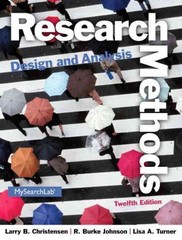Question
In early 2011, the city of Seattle, Washington changed rates for on-street parking. All results here are based on automatic transaction data from parking pay



In early 2011, the city of Seattle, Washington changed rates for on-street parking. All results here are based on automatic transaction data from parking pay stations obtained before and after that rate change. The parking rate changes were based on performance-based pricing where rates were increased, decreased, or not changed in neighborhoods with occupancy levels higher than, lower than, or within a pre-determined level. This data was used to calculate price elasticity by time of day for on-street parking demand and incorporates neighborhood characteristics to determine how on-street parking demand responds to price changes. The relationship between pricing and parking turnover, the amount of time parked, and total revenue generated for the city will be discussed. Term definitions: Parking turnover: average total number of vehicles that are parked on a weekday within a certain time-period (e.g., in a day or for an hour). Parking duration: average time vehicles are parked. Parking revenues: average total parking revenues per day. New Parking Rates
In February to April 2011, a change in the regulation of on-street parking in Seattle was implemented which resulted into both an increase and a decrease of hourly parking rates in some neighborhoods. The new rates and the parking price change in each neighborhood can be seen in Figure 2. In total, four neighborhoods saw an increase in parking rates; six neighborhoods saw a decrease; and four were unchanged.The rate change you see in the figure represents the change in dollars, for example in the commercial core the rate increased by $1.50 to $4.00 per hour after the 2011 rate change from its prior rate of $2.50 per hour. From here, you will see a variety of graphs and tables showing results from the study. This information will allow you to see estimated parking elasticity by time of day, neighborhood, parking turnover, length of time parked, and additional information. A list of questions will follow that asks you to look at the information presented in the tables, interpret it, and make conclusions. Even if there are questions you are uncertain of, include an answer, I offer partial credit.




Step by Step Solution
There are 3 Steps involved in it
Step: 1

Get Instant Access to Expert-Tailored Solutions
See step-by-step solutions with expert insights and AI powered tools for academic success
Step: 2

Step: 3

Ace Your Homework with AI
Get the answers you need in no time with our AI-driven, step-by-step assistance
Get Started


